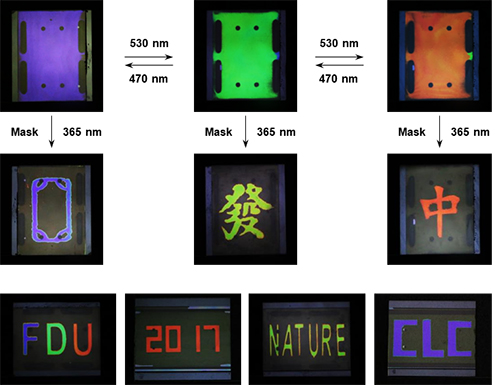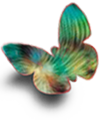Search
Title: Piecewise Phototuning of Self-Organized Helical Superstructures
Author: Lang Qin, Wei Gu, Jia Wei, Yanlei Yu*
Journal: Adv. Mater., 2018, 30(8), 1704941.
Abstract:
Cholesteric liquid crystals (CLCs) exhibit selective reflection that can be tuned owing to the dynamic control of inherent self-organized helical superstructures. Although phototunable reflection is reported, these systems hitherto suffer from a limitation in that the tuning range is restricted to one narrow period and the optically addressed images have to sacrifice one color in the visible spectrum to serve as the background, resulting from the insufficient variation in helical twisting power of existing photoresponsive chiral switches that are all bistable. Here, delicate patterns of three primary red, green, and blue (RGB) colors with a black background are presented, which is realized based on piecewise reflection tuning of the CLC induced by a newly designed photoresponsive tristable chiral switch. Three stable configurations of the chiral switch endow the CLC with two continuous and adjacent tuning periods of the reflection, covering not only entire visible spectrum, but also one more wide period within near-infrared region. Therefore, the concept of piecewise tuning in CLC system demonstrates a new strategy for phototunable RGB and black reflective display.
Fulltext Link: https://onlinelibrary.wiley.com/doi/full/10.1002/adma.201704941

The researchers design a new type of photoresponsive tristable chiral molecule by linking two azobenzenes on the chiral center of binaphthyl, so that the photonic crystals based on this material have an ultra-wide range of color regulation, which can be used to display patterns of various colors on black background. Azo and F-Azo undergo trans-cis and cis-trans isomerization reactions under the stimulation of ultraviolet and blue light, respectively. When using green light as a stimulus, Azo reverts from cis to trans, and F-Azo is isomerized from trans to cis. Since two Azo can generate three isomerization combinations under blue/green light stimulation, the chiral molecule can produce three stable configurations, providing two control bands for the cholesteric liquid crystal, extending the reflection wavelength to near infrared light region to display a black background.







